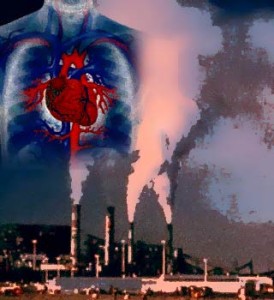Exposure To Air Pollution Increases Heart Risk
By Khalid Sheikh, MD, MBA // March 9, 2014
TAKE CONTROL OF FACTORS THAT AFFECT YOUR RISK OF HEART DISEASE
ABOVE VIDEO: Tips from the U.S. Environmental Protection Agency on how to protect your heart from air pollution.
A European collaborative study has found that individuals who lived in areas where they breathed in large concentrations of particles of polluted air over a long period had a marked increase in the risk of having heart attacks. The study further supports previous research that environmental pollutants can contribute to the risk of heart disease.

The European Study of Cohorts for Air Pollution Effects (ESCAPE) was published in the on-line edition of the British Medical Journal on January 21, 2014. The study investigated the long-term effects of exposure to air pollution in Finland, Sweden, Denmark, Germany and Italy.
Over 100,000 people were enrolled in the trial from 1997-2007, and followed for an average of 11.5 years. No patients had known heart disease at the time of enrollment. During the trial, 5,157 subjects suffered a cardiac event, either death due to a heart attack, a non-fatal heart attack or a severe angina pain episode requiring hospitalization. An increasing level of air pollutants was found to correspond with an increasing level of heart risk.
PERMISSIBLE POLLUTION STANDARDS 2X HIGHER IN EUROPE THAN U.S.
Europe and the United States have different standards for permissible air pollutant particles. In the U.S. the Environmental Protection Agency (EPA) permits air to contain a particulate matter level of up to 12ug/m3 (micrograms per cubic meter). These particulates consist of both fine and coarse particles from soot, industry and automobile exhausts and nitrogen oxide.

In Europe, the permissible level is twice this, up to 25ug/m3. The ESCAPE trial found that just a 5ug/m3 level increase in pollutants corresponded with a 13% increased risk of heart events. This risk was independent of the effects of other heart risk factors, such as age, sex, smoking and socioeconomic status.
The recent World Health Organization (WHO) report on the Global Burden of Disease estimated that air pollution causes 3.1 million deaths per year due to heart disease. For this reason, the WHO has recommended air-quality guidelines have a threshold of particle concentration under 10ug/m3. Unfortunately, 90% of the world has air pollutant levels that exceed this level, including both the U.S and Europe. In some cities, like Beijing, the level of particles has been measured as high as 100ug/m3 over a 5-year period.
BE PRO-ACTIVE IN DECREASING YOUR RISK OF HEART DISEASE
Long-term exposure to air pollutants increases your heart risk. You can find out the measured amount of pollutant particles in your community by contacting the EPA. If you live in an area with poor air quality you have need to take action to protect yourself, your family and the future generations that will follow.
Unfortunately, for most of us, the option to move to a deserted tropical island where the air is pure won’t work. In that case, do the next best thing. Take an increasing level of individual responsibility to modify those heart risk factors that are under your direct control.

Avoid tobacco exposure, exhaust fumes and maintain a healthy lifestyle for yourself. Make this an example for your family as well. If you live and work in a high-risk area, become a community and public-health advocate to help change this. Finally, take a pro-active role in evaluating and modifying your heart risk in partnership with your health care provider.
To learn more about prevention, treatment and reversal of heart disease, get the book Don’t Let Your Heart Attack!, available on Amazon, Barnes & Noble and iTunes.
ABOUT THE AUTHOR

Dr. Sheikh, a member of Health First Medical Group, directs a cardiology practice specializing in lipid management and cardiovascular disease prevention, treatment and reversal in Cocoa Beach, Florida. He was a Professor of Cardiology at Duke University before entering private practice, and is currently on the clinical faculty at the University of Central Florida College Of Medicine. Dr. Sheikh, who was recognized by the Consumers’ Research Council of America as one of America’s Top Cardiologists, is board certified in both Internal Medicine and Cardiovascular Diseases, and is a Fellow of the American College of Cardiology. He is also a certified clinical lipid specialist, board certified in adult echocardiography and has completed level I training in cardiac CT imaging. He has served as the principal investigator in over 100 national and international clinical research trials, and authored over 150 scientific abstracts, peer-reviewed journal articles, book chapters and subject reviews.
For more information about Don’t Let Your Heart Attack and Dr. Sheikh’s practice go to SheikhHeartCare.com












